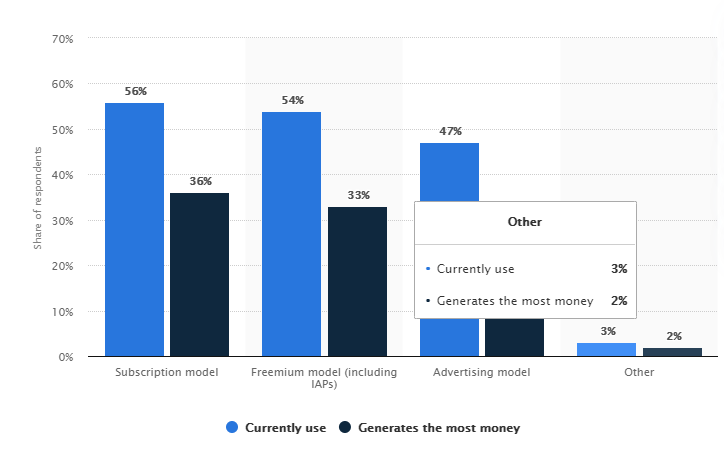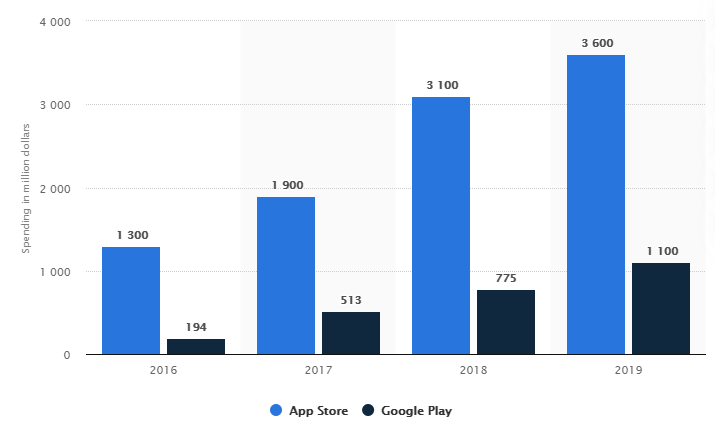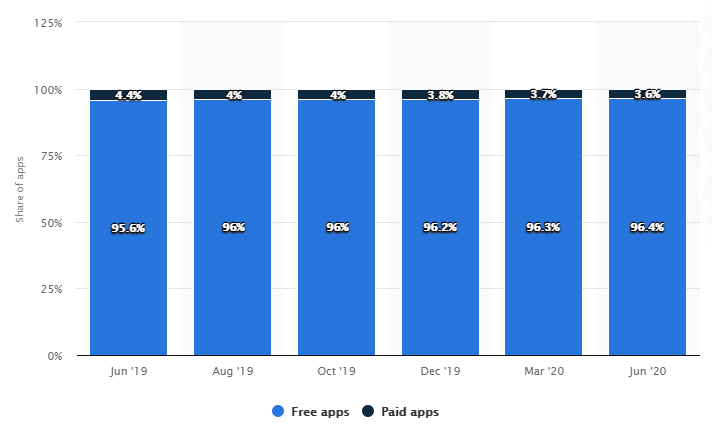A mobile app helps businesses achieve multiple goals. From providing a suitable solution for the audience's pain points to the increasing acquisition, boosting engagement, and more, an app can help with it all!
Plus, it not only gives you a competitive advantage but also acts as an additional channel for your marketing efforts.
Mobile app services are also an ideal way to earn a monetary return on investment. Thus, if you want substantial monetary value for your application, it's essential to know how to monetize an app.
App monetization strategies depend on a variety of factors, including your target market, your platform or app store, and your competitors' tactics. Meaning, deciding which approach works for you can be challenging.
Thus, here's a guide to help you understand why you need mobile app monetization strategies, the types of pricing models in the market, as well as how to monetize an app.
Why Do You Need to Monetize Your App?
App monetization can be defined as a tactic to turn your app users into monetary earning. It involves strategic planning so that instead of a positive revenue, you don't find your users switching to competitor apps.
Plus, among the numerous applications in app stores, it's become common to find apps that are free at the point of download. Thus, to keep up with the trends and to survive the competitive market, you need an app monetization strategy.
That said, you need to ensure two things when planning your strategy:
Continuous earning and growing revenue
Maintain user experience to retain your user base.
Monetization Models to Leverage
Mobile app monetization strategies are challenging to plan and implement because there are several ways you can generate revenue through an app. You can choose one pricing model or opt for a hybrid approach.
That said, before we look at how to monetize an app, you need to understand the different pricing models, how they work, which ones are effective, and which will work best for you.
According to Statista, some of the leading monetization models, in terms of revenue generation and use include subscriptions, in-app advertising, and freemium models.
 Source: Statista
Source: Statista Let's take a look to see what they entail:
In-App Advertising
Apps that are free to download can earn revenue in two ways: in-app advertisements and in-app purchases. The in-app advertising approach works best with a large user base, from whom you can collect information for targeted ads.
Plus, with mobile apps taking center stage in our digitized world, in-app advertising is a phenomenal opportunity, you can't miss. Types on in-app adverts you can place to monetize your app:
Banner ads
Native ads
Interstitial ads
Affiliate ads
Reward ads
That said, there's not a one-size-fits-all approach when it comes to in-app adverts. Each app has a separate plan, but they all prioritize ad placements to get the most out of their monetization strategy.
Placement of in-app ads is a crucial factor to consider when planning your app monetization strategy. Pushy or intrusive adverts that disrupt user experience will only cost you your users. Plus, proper placement of highly targeted ads will provide value to not only the advertiser but also the user, in terms of relevant content.
In-App Purchases
In-app purchase is another way to monetize apps, most commonly used in gaming apps. According to a survey in 2018, the pricing model was acclaimed as the number one source of mobile app revenue.
Through in-app purchases, apps are free to download, but users must buy services, particular features or upgrades like game boosters, to enjoy additional app function.
It can be an excellent method to boost engagement, but it's essential that each in-app purchase adds to the user experience, not disrupt it.
In-app purchases are also an ideal way to let your users try your app before asking them to make a purchase. It helps acquire a broad audience, which, in turn, boosts revenue.
On the other hand, with each earning through in-app purchases, you also need to account for the app stores' commission. Apple and Google Play are known to request a 30% per sale.
Subscriptions
Subscriptions monetization strategy allows you to provide your users with more options than buy or don't buy. Plus, it is another way to ensure app download is free so that the users can download the app before paying for its features for a specific time.
The model works best to attract a substantial user base, which forms a reliable source of monetary revenue and user engagement. Plus, the continuous renewal of subscriptions provides a steady stream of income, which makes it a preferred monetization strategy for developers.
That said, iOS users are much more likely to spend on subscriptions than Android users, according to Statista.
 Source: Statista
Source: Statista Conversely, with subscription app monetization strategies, it is challenging to determine the perfect amount of content to offer before requesting users to subscribe for continued use.
That said, the model is ideal for you if you have an app that encourages continued use such as news, media, music, or streaming apps.
Sponsorships & Partnerships
It requires collaboration with advertisers who will sponsor the award for your users on performing specific in-app actions. For a sponsorship pricing model, you need a broad audience or a niche that attracts brands to collaborate and pay for their promotion.
Partnership, on the other hand, requires you to collaborate with another app that has a similar target market as yours. It works to benefit you and your partner mutually, allowing you to expand or improve your products and increase your user base.
The pricing model works best if you have a significant audience and find a partner that provides value to your users.
However, if the partnership is cohesive, then you could end up confusing your users, which would influence your retention rate.
Freemium Model
Freemium models work by allowing free downloads but keeping certain features under lock and key. Users can unlock additional app functions by making a purchase.
Free apps gain a massive user base much faster than paid apps, which makes freemium and the above pricing models an effective way to build your target audience. It also allows for multiple revenue streams. You can earn through in-app adverts for free users and via paid upgrades for others.
Conversely, however, you should note that freemium models can take some time to become profitable. Meaning, aside from a large group of users, you also need patience and dedication to find success.
Paid Apps
Paid apps charge on download, which makes the monetization model rather disadvantageous. It's because, with the number of free apps in the market, you need a compelling reason for users to choose your app over your competitors' free apps.
Plus, Statista says that the number of free apps continues to rise, while paid apps fall every year:
 Source: Statista
Source: Statista On the other hand, paid apps do have their positives, like a loyal user base and higher engagement. Plus, revenue is upfront and proportional to the number of downloads. So, it is worth the investment if you have a reason for users to choose your app.
How to Monetize an App: Best Practices to Boost Revenue
App monetization strategies are not only about integrating a pricing model within your app and hoping to gain a significant monetary return. Instead, you need to decide the best approach for your business, choose a single model, or consider a hybrid strategy.
Additionally, you also need to consider the user journey and ensure not to disrupt the user experience. Monetizing in ways that will annoy users will affect your reputation and the retention rate.
Thus, if you understand the different pricing models at your disposal and how to monetize an app, let's look into how you can elevate your mobile app monetization strategies.
Hybrid App Monetization
Hybrid app monetization involves integrating more than one pricing model within your app. If you maintain user experience and ensure not to do too much, implementing multiple mobile app monetization strategies can be immensely beneficial.
Measurement & Analytics
Measurements and analytics allow you to optimize your strategy. Additionally, if you are working with a partner, ensure that they can provide analytical insights on revenue, users, and geography. That said, here are some points to follow when you monetize apps:
Keep Up to Date
Aim to remain in the know with any changes in policies from significant app platforms. It may change overnight and can influence your app monetization strategy, so you must follow the latest resources to keep updated.
Consider a Strategy that Works for You**
Every app is different, as is your business. Thus, don't just consider your competitors' use case will work for you as well. Test and experiment with different ways to monetize apps and find what works for you before implementing your strategy entirely.
Ready to Monetize Your App?
By now, I hope the blog helped in understanding how to monetize an app. If you need assistance with strategic planning, here are a few questions to ask yourself:
How is your app unique?
Would people pay for it and how much?
What pricing model do your competitors use? Does it work for them?
What do you aim to earn from your mobile app: more users or revenue?
In a nutshell, a mobile app can be immensely beneficial to earn a high return on investment in terms of revenue, user engagement, brand awareness, and more. So, how your app makes money depends on what you aim to gain.
That said, are you ready to monetize your app? Our consults are on standby to lend a hand, so drop an email or call and we'll help you plan the best monetization strategy for your business.

